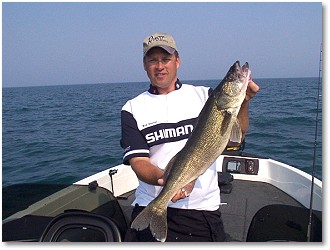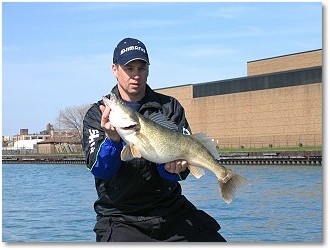| There is nothing that I enjoy more than getting out to run crawler harnesses after 1 month of chasing jigs on the Detroit River.During the month of April I am on my Minn Kota vertical jigging for walleyes and watching my fishing line as well as my clients.So when Lake Erie’s walleye season opens I am thrilled to get out and relax trolling, but it is not that relaxing! Many of the migrating walleyes that were in the Detroit River and surrounding rivers spawning are headed back to Lake Erie. After you find these walleyes get ready for some non-stop action.
Early season action usually starts near the village of Colchester on the north shore of Lake Erie. This is a fishing community that loves their walleye, bass and perch fishing. They have a great facility and the staff is very helpful and willing to give you a fishing report from many of the locals. Most action during the early part of the season will take place near Holiday Beach just west of Colchester. For many crawler harnesses will be the preferred lure. Harnesses not only have the flash of an artificial lure but the scent of a live night crawler and the added thump of a blade.
For those that are relatively new to using harnesses, we look at 50 degrees to be the key. Below 50 degrees most will use crankbaits. Am I saying that above 50 cranksbait won’t work? No, it is just when the harnesses become effective.
I enjoy using harnesses because they can be fished from top to bottom. I use them in a variety of ways, bottom bouncing, in-line weights and with Off Shore snap weights. Usually after the spawn big walleyes will sit on the bottom to recover from the rigors of the spawn. This is where I will use bottom bouncers most of the time. As the season moves on and the water warms I will look at running in-line weights for suspended walleye.
Now for the nuts and bolts of equipment needed to catch these fish. A good quality line counter reel is a must. Even if you are bottom bouncing it will help and with new friends on board it makes things much easier. I remember a few years back taking my mother in law out for her first time trolling for walleyes and she was setting lines in no time. For those that have never fished this way, they become involved with the operation and it makes it fun being a part of the action.
As for rods I like a 7-6 to 8-6 rod with a soft tip, longer rods act as a shock absorber. I use the Shimano 7’10 Clarus and Compre walleye series rods that telescope to fit in the rod locker. For those looking to buy rods for trolling buy at least 2 or 4. Matching equipment not only looks good but is a key to repeating your ability to catch more fish. If you have a mix and match set of rods your baits will run and act differently. Just like having a complete set of golf clubs, they all react the same. Fishing line is another factor. Most of the information that has been gathered in the Precision Guide to Trolling is based on 10# mono fishing line. Using a line with the same diameter will have your baits running at depths that are recorded in the helpful book. Although it is mostly for crankbaits it does contain info regarding using worm harnesses. I do use braided line but it is not necessary for worm harness fishing.

And finally in-line planer boards to get your lines away from the boat. I use the Offshore OR-12TF with the Tattle Flag attachment.
Most regard the use of boards to keep the line away from motor noise, but it is mostly to spread your lures to cover a larger area. It also makes it easier to fish multiple lines and cover different water depths where you can legally run more than 1 rod per person. When fishing harnesses with the slow speeds that are used I very rarely fish into the wind. I like putting my transom to the wind and going with it. Fishing into the wind is a tough job. When you are only fishing at tops for me 1.5 mph you need someone on the wheel at all times. I like to put the kicker motor or turn on the engine mounted electric and go with the flow. With the addition of the new engine mounted electrics from Navigator or Minn Kota you can turn most boats into a walleye trolling machine.There are many choices of blades, not only colour but for size and shape. Most of the blades I use are the Colorado blades with number of Indiana blades to mix it up. I rarely use willow leaf blades, that is my personal choice. I use what I have confidence in. I usually start with a size 4 Colorado in May and buy early to mid-June I am not afraid to run a number 7 or 8 Colorado.
Colours are the next decision to be made. The best part about fishing the great lakes and the inland waters of Michigan that I fish we are permitted to run 2 rods per angler. That being said I usually have a chance to run a variety of colours and depths. In clear water I like silver, copper, purple and gold. For stained water, chartreuse combos work well and a larger blade will add the thump that is needed to attract walleyes. In the last few years companies have made prism tapes to add to the finish of your blade. I keep a selection of these tapes in my tackle box to make changes while I am on the water. Not only do I keep extra prism tape and blades but I also have numerous harnesses pre-tied with just the hooks and I will make harnesses while I am on the water. For those people that do not make their own harnesses, Northland Tackle makes a great assortment of factory made harnesses.
Many will believe that these techniques are just for great lakes open water fishing, but this type of fishing can be used for smaller inland waters too. For fishing smaller bodies of water I have run ¼ and 3/8 oz bullet weights to avoid catching weeds. It is similar to most of the cottage country lakes and this is where the bullet sinker comes in handy. We would run the baits back about 15-25 feet behind the in-line planer boards. We would be fishing water depths of 8-12 feet of water with many weed lines adjacent to the areas we were fishing. So whether you are fishing the great lakes or inland waters, worm harnesses are an excellent choice to fish from top to bottom.

Bob Devine is a charter guide and a member of the Outdoor Writers of Canada. His columns and photo’s are published for Southwestern Ontario Outdoors Magazine, Bob Izumi’s Real Outdoors, Canadian Sportfishing, Outdoor Canada and Canadian Sportsman. For More Information on Bob Devine Charter Talk Guide Service please visit CharterTalk.Com |